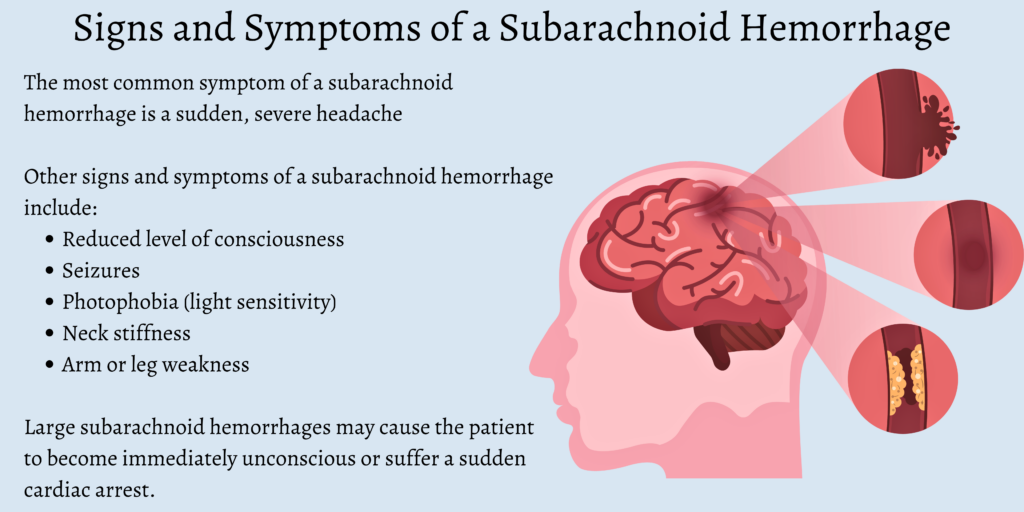What is a Subarachnoid Hemorrhage (SAH)?
A subarachnoid hemorrhage, sometimes known as a ‘bleed on the brain’, occurs when bleeding occurs in the subarachnoid space. The subarachnoid space lies beneath a layer of one of the brain’s coverings known as the meninges. First aiders and first responders should be aware of subarachnoid hemorrhage as this is a life-threatening emergency condition.
The most common cause of a subarachnoid hemorrhage is the rupture of an aneurysm. An aneurysm occurs when the walls of blood vessels become weakened and the blood vessel dilates. Aneurysms are at risk of rupturing and bleeding. Risk factors for developing aneurysms in the brain include smoking and high blood pressure (hypertension). People with kidney problems, such as polycystic kidney disease, are also more prone to developing aneurysms.
What are The Signs and Symptoms of a Subarachnoid Hemorrhage?
The most common symptom of a subarachnoid hemorrhage is a sudden, severe headache. The patient may describe the headache as being the worst headache they’ve experienced. Some patients may describe the pain as like being hit over the head with a baseball bat.
Other signs and symptoms of a subarachnoid hemorrhage include:
- Reduced level of consciousness
- Seizures
- Photophobia (light sensitivity)
- Neck stiffness
- Arm or leg weakness
Unfortunately, large subarachnoid hemorrhages may cause the patient to become immediately unconscious or suffer a sudden cardiac arrest.
The following quote is a description of suffering a subarachnoid hemorrhage from the Game of Thrones actress Emilia Clarke:
“Basically I was in the gym, the most excruciating pain, like an elastic band just went, like, snap in my head….an enormous amount of pressure suddenly, and then very very very quickly, I realised I couldn’t stand and I couldn’t walk, and in that moment I knew I was being brain damaged.”
– Emilia Clarke
How is Subarachnoid Hemorrhage Diagnosed?
As a first aider, diagnosing a subarachnoid hemorrhage is impossible. Instead, the condition must be diagnosed in a hospital by trained specialists.
The most commonly used diagnostic test is a CT scan. This medical imaging technique uses multiple x-rays taken from various angles to create a detailed three-dimensional cross-sectional image of the inside of the body (in this case, the brain).
A lumbar puncture test is also sometimes used. It involves inserting a needle into the base of a patient’s spine to collect a sample of cerebrospinal fluid. It’s then analyzed in a lab for signs of bleeding, indicating a subarachnoid hemorrhage.
If a CT scan and lumbar puncture are inconclusive, an MRI or MR angiogram may be used. And in difficult-to-diagnose cases, the doctor may request a Cerebral angiography. It involves inserting a thin tube (a catheter) into an artery and sending it into the brain. A dye is released into the blood vessels to create a clearer x-ray image.
What is the First Aid Treatment for a Subarachnoid Hemorrhage?
The main first aid treatment for a suspected subarachnoid hemorrhage is to recognize the condition and call for emergency medical help. These patients may require urgent surgery (neurosurgery) in order to stop the bleeding inside the brain.
As a first aider, there’s nothing you can do to stop the bleeding. Instead, monitor the patient until emergency medical help arrives. If the patient is unconscious or has a seizure then ensure the airway is open and clear. Monitor vital signs and provide reassurance until medical help arrives.
Subarachnoid Hemorrhage Recovery
Recovery time after a subarachnoid hemorrhage depends on the severity of the condition, the patient’s health, the location, and the type of treatment used.
A subarachnoid hemorrhage is a severe brain injury. Depending on the extent of the damage, it can lead to long-term issues that can last for months or even years.
These include loss of sensation in the limbs, trouble with speech and language, extreme fatigue, insomnia, headaches, impaired memory, emotional imbalances, vision problems, weakness, loss of movement, a change to the sense of taste and smell, and unusual sensations in the brain.
These symptoms are all commonly reported during recovery from SAH. Still, for most people, they will diminish gradually over time and may eventually disappear altogether.
Life Expectancy After Subarachnoid Hemorrhage
A subarachnoid hemorrhage is a life-threatening condition; sadly, around 1 in 8 people will die before even reaching the hospital. But over 8 out of 10 admitted to the hospital will survive.
50% of survivors fully recover, with mild to zero long-term effects. The other 50% are left with a permanent disability.
Younger people and those who remain conscious during a subarachnoid hemorrhage have better outcomes.
FAQs
Who is most at risk of a subarachnoid hemorrhage?
Subarachnoid hemorrhages are most commonly seen in patients under the age of 60. However, the condition is seldom seen in children.
People of African and Japanese descent are more likely to have a subarachnoid hemorrhage than those of European descent.
Subarachnoid hemorrhages also have a genetic link. Those with a mother, father, sister, or brother who has had a SAH are at an increased risk of developing one themselves.
What are the warning signs of a subarachnoid hemorrhage?
A subarachnoid hemorrhage is usually sudden and unexpected. Still, some people may experience warning signs in the days or hours leading up to the event.
These include:
-Short bursts of headaches are painful but not as painful as during a subarachnoid hemorrhage.
-Pain in and around the eyes
-Dizziness or feeling faint
-Altered vision
-Loss of feeling and temporary paralysis of the limbs
Aside from aneurysms, what are the other causes of subarachnoid hemorrhage?
An aneurysm causes 8 out of every 10 cases of subarachnoid hemorrhage, but what about the rest? Other causes include:
-Severe head or neck injury.
-Brain tumors
-An infection of the brain
-Vasculitis is when blood vessels become enlarged and inflamed inside the brain.
How common is a subarachnoid hemorrhage?
Subarachnoid hemorrhages are relatively rare and occur in 8 out of every 100,000 people yearly.
How can the risks of subarachnoid hemorrhage be reduced?
While it isn’t known why many people suffer a subarachnoid hemorrhage, certain risk factors have been identified. So, to reduce the chances of SAH, doctors recommend:
-Quitting smoking
-Reducing alcohol intake
-Avoiding illicit drugs such as cocaine
-Lowering/maintaining a healthy blood pressure
-Maintaining a healthy weight
-Getting plenty of regular exercises
Conclusion
The sooner the subarachnoid hemorrhage is treated, the better the outcome. That’s why it’s so important that first aiders familiarize themselves with the signs and symptoms of the condition so that they can seek lifesaving medical treatment for the patient as soon as possible. For more information on different types of brain injuries, please read our guide to primary vs. secondary brain injuries. Learn the lifesaving first aid skills you need to respond to them.







